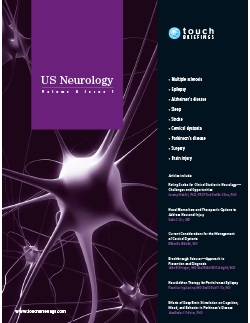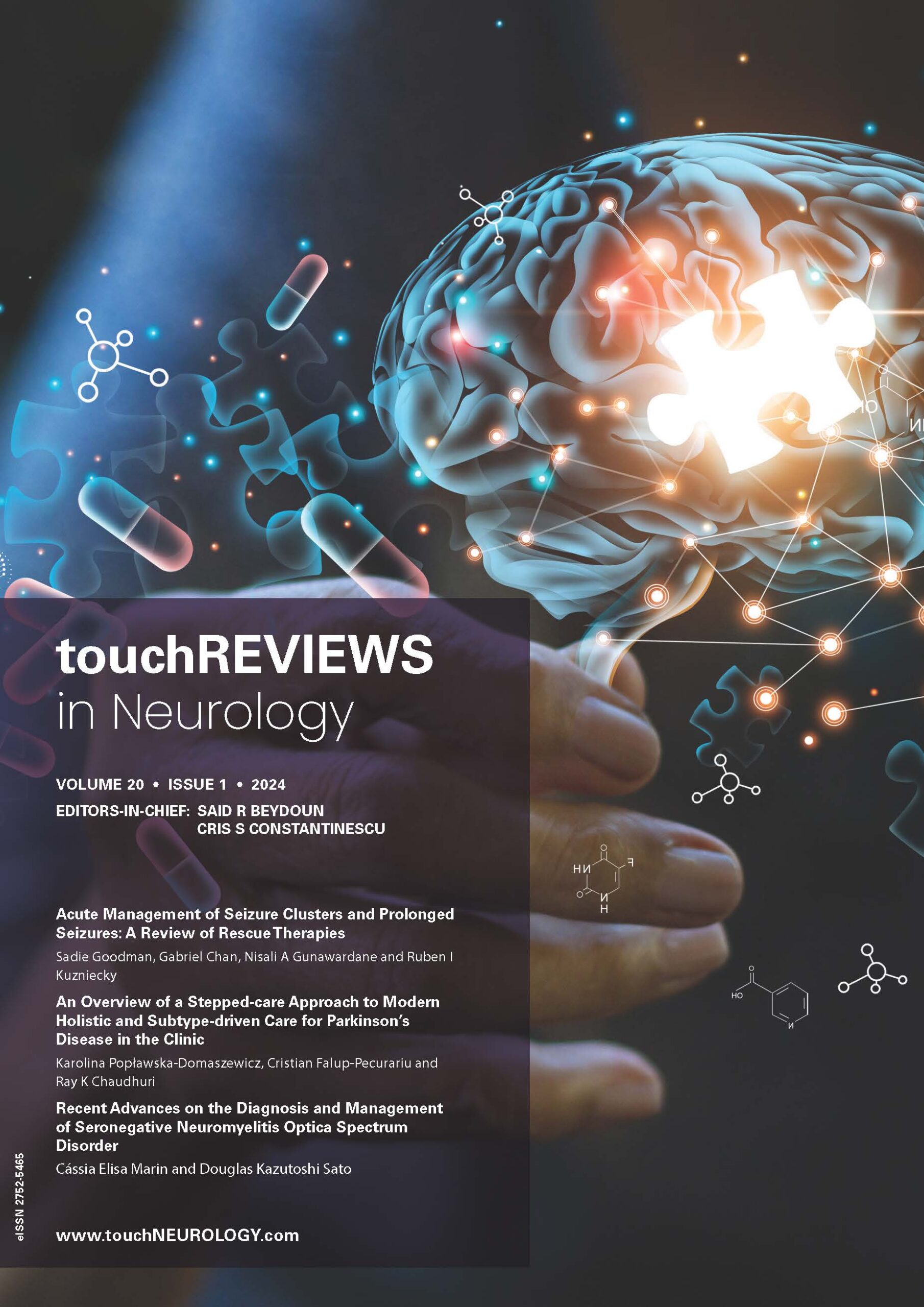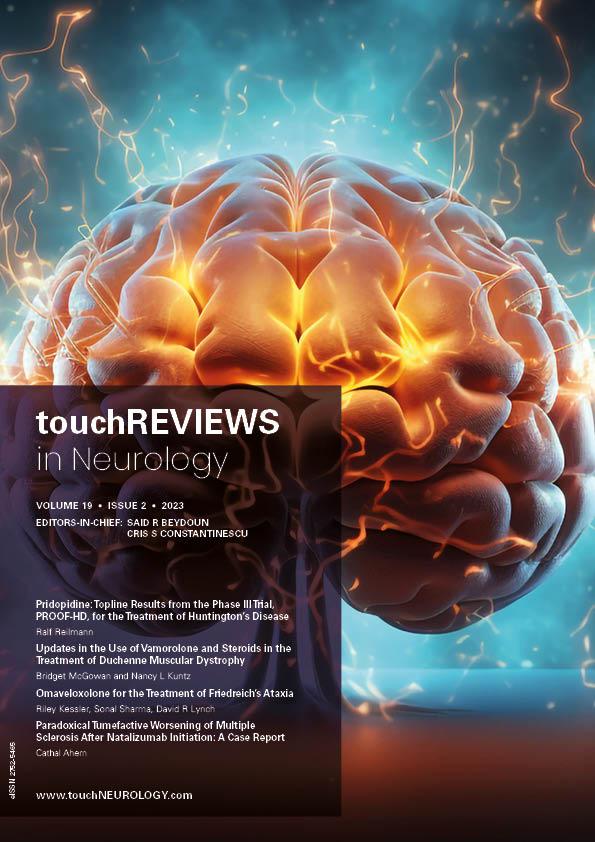
US NEUROLOGY – VOLUME 4 ISSUE 1 – SPRING 2008
Foreword
As neurologists, we are surrounded by advances in our professional field, and we often find ourselves with more questions than answers. It is the remit of journals such as US Neurology to keep us informed. One particularly important question is ‘are we at the dawn of rational disease modification in Alzheimer’s disease?’ Existing medications for […]
Multiple Sclerosis
Rating scales are increasingly used as primary or secondary outcome measures in clinical studies in neurology.1 They are therefore becoming the key dependent variables upon which decisions are made that influence patient care and guide future research. The adequacy of these decisions depends directly on the scientific quality of the rating scales, which is reflected […]
Four clinical dimensions can be impaired in multiple sclerosis (MS): neurological function, cognition, emotions, and fatigue. Neurological impairment, cognitive deficits, and fatigue are recognized to be part of the functional handicap and deterioration of quality of life in MS patients, while the effect of emotional impairment, which includes behavioral changes and decision-making difficulties, has been […]
While recognizing that the factors that enter into a decision to treat are complex and best analyzed by the individual patient’s neurologist, the National Clinical Advisory Board of the National Multiple Sclerosis Society has adopted the following recommendations to provide guidance to clinicians, insurers, and policy-makers regarding the appropriate use of corticosteroids in the management […]
Alzheimer’s Disease
Studies show that the aging population is at increased risk for folate deficiency, which may contribute to cognitive decline.1 Data reveal that with increasing age, serum and cerebrospinal fluid (CSF) folate may drop below normal levels, while serum homocysteine (Hcy), a sensitive marker of functional folate deficiency, may rise to above normal levels. The association […]
The pathobiology of Alzheimer’s disease (AD) is extremely complex and not yet fully understood. AD is characterized by the clinical syndrome of a slowly progressive dementia and the classic neuropathological findings of amyloid plaques, neurofibrillary tangles, and neuronal death.1 These histological features develop in heterogeneous patterns and in people with varying genetic predisposition, nutritional histories, […]
The inability of pharmacologically based therapeutic molecules, such as the cholinesterase inhibitors and memantine, to effectively prevent clinical deterioration in Alzheimer’s disease (AD) over the long term has stimulated the search for more effective therapeutic approaches that may have the ability to show significant disease-modifying activity. Immunotherapeutic approaches are perhaps the most exciting potential therapeutic […]
Cervical Dystonia
Cervical dystonia (CD) is a focal dystonia of neck and shoulder muscles that causes neck and shoulder pain, limitation of neck movements, and, sometimes, involuntary head and neck movements. Primary CD is the most common form of adult-onset focal dystonia, with a prevalence of six to nine per 100,000 population.1,2 The peak age at onset […]
Epilepsy
Q: Why is there a need to focus on breakthrough seizures? A: When an epilepsy patient experiences a sustained period of freedom from seizures (seizure control), then suddenly experiences a seizure, such an event is commonly referred to as a breakthrough seizure. When these breakthrough seizures occur, there can be severe clinical consequences for the […]
Perturbations of the electrical oscillations of the cerebral cortex of epileptics were first demonstrated by Berger,1 soon after he discovered the existence of recordable brain electrical activity in humans in July 1924. Although interested in electroencephalography (EEG) not as a medical tool but rather as a physical measure of mental processes, Berger’s writings provided the […]
Adequate control of partial-onset epilepsy often requires polypharmacy, either due the to less than ideal efficacy of one antiepileptic drug (AED) (see Table 1) or due to side effects caused by the initial AED (see Table 2). Up to one-third of patients with partial-onset epilepsy will require treatment with more than one AED.
Sleep
Circadin® (Neurim Pharmaceuticals) is a prolonged-release formulation of 2mg melatonin (PR-melatonin 2mg) that, when taken before bedtime, mimics the physiological pattern of melatonin excretion during the night. It was approved by the European Medicines Agency (EMEA) in June 2007 for the short-term treatment of primary insomnia characterized by poor quality of sleep in patients over […]
It is more than 125 years since the classic description of narcolepsy was presented by Gélineau. Since then much has been learned about the background, diagnosis, and management of narcolepsy, especially over the last few decades. It is likely that hypocretin-producing cells in the lateral hypothalamus are selectively destroyed in genetically susceptible individuals carrying one […]
Stroke
For decades, the overwhelming emphasis on the development of therapeutic interventions for the treatment of stroke has been in the area of neuroprotection, acute intervention to reduce the volume of cerebral infarction, and the sequellae of secondary cell death, whether by necrosis or apoptosis.1,2 Concerted efforts to elucidate mechanisms of cell death were translated into […]
Pharmaceutical Recanalization Therapies
Parkinson’s Disease
Parkinson’s disease (PD) is generally considered to be a neurological disorder. However, because of the frequency of mood and other psychiatric complications, PD could be considered a neuropsychiatric disease. In fact, James Parkinson himself observed in 1817 that depression is commonly associated with PD.1
Disappointed by the limitations of pharmacotherapy, emboldened by technological advances in surgery and radiology, and armed with a better understanding of pathophysiology, physicians and scientists in the 1980s charted a renaissance of surgery for movement disorders such as Parkinson’s disease (PD). The desire for a safer alternative to lesional or ablative neurosurgery, coupled with observations […]
Surgery
The revolutionary discovery of transcranial electrical stimulation (TES) by Merton and Morton1 became a well recognized method for corticospinal tract (CT) activation and has been used in the clinical setting for the last 25 years. Due to the painless method of brain stimulation and other advantages after introducing transcranial magnetic stimulation of the brain, TES […]
Meningiomas comprise approximately 20% of adult primary intracranial neoplasms.1 Of these, benign meningiomas are known to have an indolent growth pattern, usually without infiltration into adjacent nervous tissue.2–5 Because meningiomas have a well-circumscribed character, surgery has historically been the preferred treatment when total resection can be achieved with reasonable morbidity. Surgical resection has resulted in […]
Brain Injury
Since the end of World War II, the strictly medical management of and rehabilitative interventions for persons with various disabilities (including those following stroke and head trauma) have been supplemented by various paramedical remedial or functionally enhancing services (e.g. physical and occupational therapies, speech therapy, and psychological and vocational counseling). However, such interventions (which have […]

Trending Topic
Amyotrophic lateral sclerosis (ALS) is a neurodegenerative disorder of upper and lower motor neurons that results in progressive motor impairment. ALS is the most common disease of motor neurons with an annual incidence of approximately 1.7–2.5 per 100,000 people. It is a terminal condition with a typical life expectancy of 2–5 years from symptom onset. […]
Journal Archive
touchREVIEWS in Neurology is a peer-reviewed, free-to-access, bi-annual neurology journal comprising review articles, case reports, practice guides, theoretical discussions, and original research. It features balanced and comprehensive articles written by leading authorities, addressing the most important and salient developments in the field of neurology.
Latest articles videos and clinical updates - straight to your inbox
Log into your Touch Account
Earn and track your CME credits on the go, save articles for later, and follow the latest congress coverage.
Register now for FREE Access
Register for free to hear about the latest expert-led education, peer-reviewed articles, conference highlights, and innovative CME activities.
Sign up with an Email
Or use a Social Account.
This Functionality is for
Members Only
Explore the latest in medical education and stay current in your field. Create a free account to track your learning.





